The Definitive Guide to ETL & Data Integration for Marketers
ETL – Extract Transform Load
Learn everything about the most important technical acronym for modern, data-driven marketers.



Marketing is everywhere and it affects us all. The data it generates is everywhere, too. It lives on various platforms, in large amounts, and is collected through an ever-growing number of tools and applications. And if that weren’t enough, it is also constantly changing.
The International Data Center (IDC) predicts that “by 2025, the global datasphere will grow to 163 zettabytes,” or the equivalent of 163 trillion gigabytes. Or ten times more than the amount registered in 2016.
That’s a lot of data.
For marketers, in particular, an exponential increase in data can seem like the challenge of a lifetime. Collecting it, cleaning it, putting it all together and making sense of it to derive business insights is a lot to deal with. Yet, the companies that do master that process will be the ones set themselves apart from the pack. You’d probably want to be one of them.
So, how do you take control of your data and get it to work for you? The answer is ETL. An abbreviation that – unlike many others – just rolls off your tongue.
On this page, you’ll learn everything there is to know about these three letters and why they are so important for the work of marketers out there.
Let’s start with the basics…
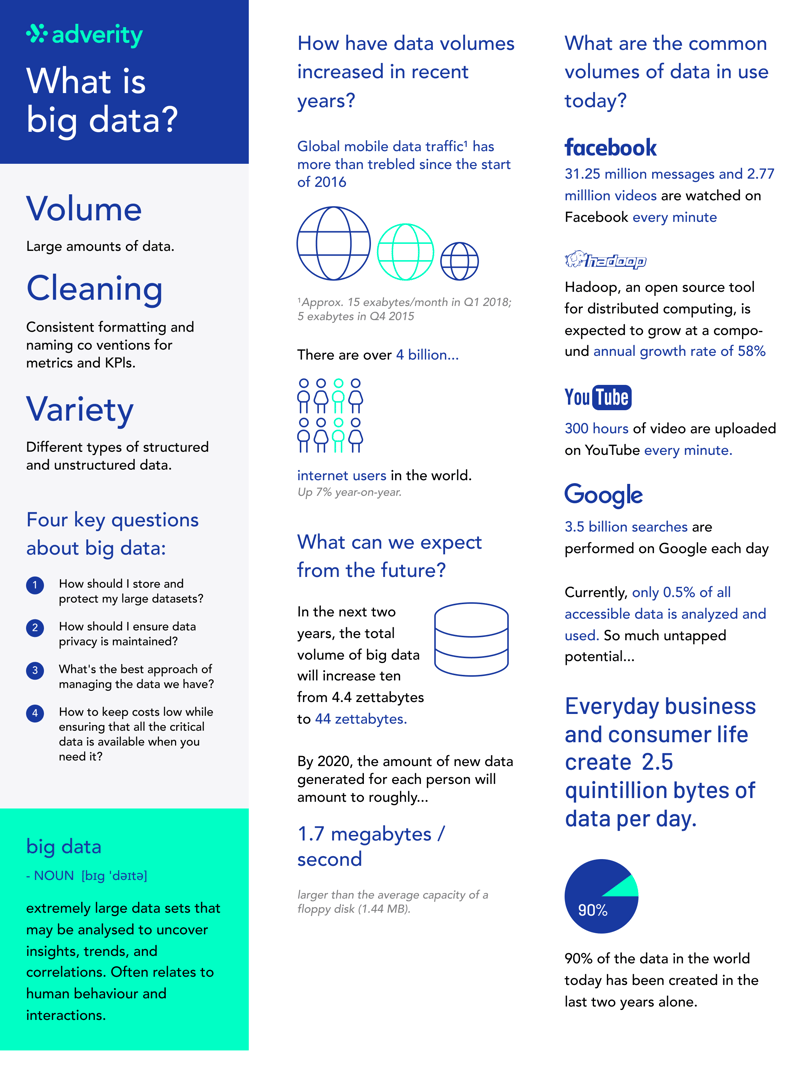
ETL is the foundation of today’s data-driven marketing, even if it’s an abbreviation you don’t hear too much about. It essentially separates the analysis part from everything that comes before it.
It stands for extract, transform and load, and essentially describes a three-step process.
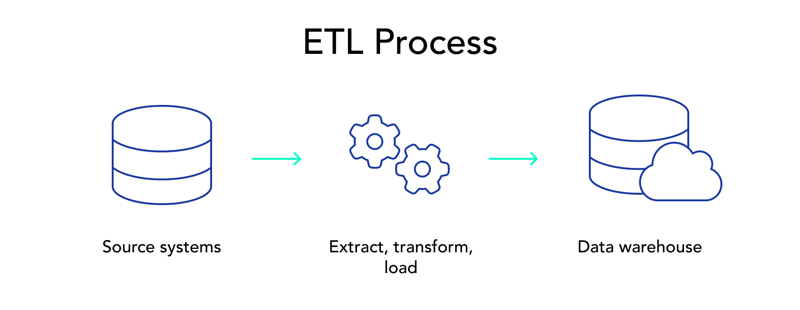
Extracting data is about acquiring it from a particular source and doing so in a way that all relevant data is collected. For ETL to work well, data needs to come directly from the source and in its rawest form.
Transforming data requires it to be stripped of its various formats, cleaned, and harmonized. Put differently, it needs to become easy for the end-user to read. Ensuring the highest possible data quality is crucial during this process, including detecting and removing duplicates and sorting the data into relevant, predetermined categories.
In the end, your ETL tool will help harmonize your data and load it into a target location, which essentially is a business intelligence (BI) or database tool of choice. There you can find it ready for your analysis.
Automated processes will save you time
The beauty of ETL lies in its ability to collect, transform and assemble data in an automated manner, thus saving users the time and effort of doing so manually. Gone are the days when rows and rows of data would be imported and analyzed manually.
Complex data is no longer a challenge
The data you work with is sure to be complex and rather varied. To start with, it probably includes different timestamps, currencies, and campaign names. Add location coordinates, customers’ names, devices IDs, sellers' URLs, and time zones to the mix, and you can easily have yourself a full-time data-formatting job. ETL can take that hassle away from you.
Human error is not an issue anymore
As careful as marketers maybe with their data, they are not really immune to making mistakes. No one is, for that matter. And a mistake in the early stages of the data analytics process can be critical. One mistake will lead to another will lead to another – it’s a chain reaction of massive proportions. An ETL tool can help you avoid that.
It is the path to better decision-making
By automating crucial data processes and minimizing the chance of error, you make sure that the data you get to analyze is of the highest quality possible. And high-quality data is at the heart of making strong business decisions.
Higher return-on-investment (ROI) is in plain sight
This one is as logical as it is important. By saving you time, effort, and resources, ETL helps you boost your ROI in the long run. The fact that it can help you generate better and stronger insights is just another one of its perks.
“Before data can begin to provide marketing intel, it must be collected, combined, updated as new data is generated and analysed… These steps represent 80% of the success or failure in data intelligence projects.”
- Bill King, Marketing Analytics Expert
For ETL to really work in your favor, you need to make sure that it can indeed fulfil your data aspirations. With the help of ETL testing, you can determine if the insights you are deriving are as strong as you need them to be.
Completeness testing, for instance, looks into whether or not your data has been collected in its entirety. Testing the after-transformation, in turn, involves making sure that all the data has been processed the way you want it. An accuracy check ensures that your data is being transformed correctly, and that it fits into the right formats and categories. Without this, the rest of your data analytics process will be chaos.
In the end, you need to make sure that you test the overall performance of your ETL process. Find out how much data your tool can handle at any point in time and what you can do to eliminate bottlenecks.
Eventually, you need to make sure that you test the overall performance of your ETL process. How much data can it handle at any one time, are there any bottlenecks and what can be done to minimise them? Find the answers to those questions and optimise your ETL process to avoid any doubt being cast over your data insights later on.
ETL and data integration are often being used interchangeably, but it is important to note that with the advance of data marketing technologies, ETL alone is not enough anymore to handle the growing amounts of data out there.
Nowadays, data integration is a combination of several processes, including ETL, ELT (a variation of the first) and often a process called data federation.
ELT focuses on collecting the data first and giving users a chance to take a closer look at it before it is transformed. This adds a human element to the tech side of data integration and offers users the opportunity to assess which data would be most relevant for their analysis.
“Data federation, on the other hand, has the ability to aggregate data from disparate sources in a virtual database so it can be used for business intelligence or other analysis,” According to Techtarget. While virtual databases do not contain the actual data, they provide information on what that data is and where it resides.
If we were to look at this objectively, ETL and ELT are two different means to the same end goal: They help professionals get all their relevant data harmonized and ready for analysis as painlessly as possible in order to derive meaningful insights from it.
ELT stands for ‘extract, load and transform’, which looks almost identical to ETL, but hides one main difference. Instead of transforming the data first and then loading it into a target database, ELT first loads the data and then looks into any necessary cleaning up processes.
While the output of ETL is clean and ready-to-use data – which, yes, sounds amazing indeed, ELT solutions tend to give decision-makers the freedom to explore their data before transforming it. Both processes have the same end goal in mind, and they both have their strengths. So which one is it going to be?
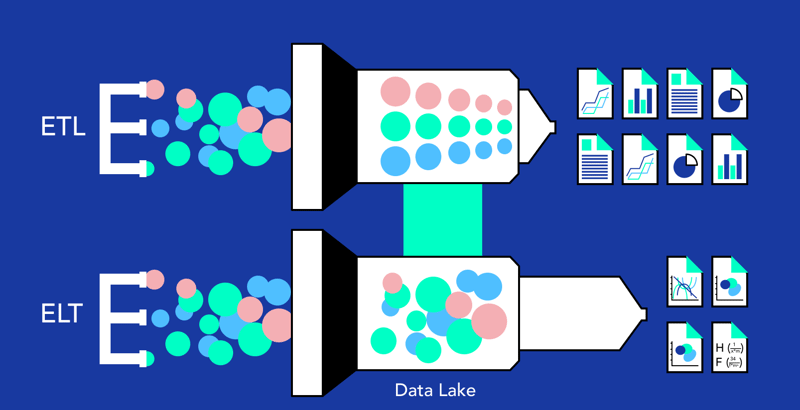
If you want to achieve the right balance, consider integrating both processes into your strategy. They both have their strengths and together they will take less time and effort to bring you to your end goal.
A data strategy is not just collecting data. It starts with a definition of your goals and continues with asking the right questions. What data do you need? What is the best place to store it? What kind of software do you need for its analysis?
In the beginning, there is one thing you need the most: patience. We know from our own research that 70% of CEOs see analytics as a key for their success, yet only 25% agree on the fact that they are in a good position to extract insights from their data. This gap shows that ambition and business reality are unaligned. By a lot.
Without realistic goals and the right strategy, data is just a clunky mess. But it really does not have to be that way. By creating a data strategy – or simply putting in place certain processes and structures to guide the way your organisation uses data, you can be sure that the insights you get eventually support your business decisions and get you closer to your monthly, quarterly or yearly goals.
As with anything in life, there are do’s and don’ts to your data strategy, too. To derive actionable insights from your clients marketing data, you need to keep your eyes set on the following 7 points:
Nowadays, nobody is really a stranger to data fragmentation anymore. Data fragmentation begins with your very first marketing efforts. You launch several online campaigns, publish a bunch of ads and you already have a storm of data coming your way. You also get a number of different data sets – or silos – and the task to make sense of them in the context of your overall marketing performance.
For more on data silos, check out our blog here!

A silo mentality “occurs when several departments or groups within an organisation do not want to share information or knowledge with other individuals in the same organisation,” According to Investopedia.
A siloed work environment puts a stop to effective communication and new ideas, and creates a bubble around topics. The move to break down silos starts with a unified vision and the strife towards one or more common goals. There also needs to be open access to data, information and knowledge – at least to the extent that all relevant stakeholders are involved.
As a marketer, some of your main priorities are to generate leads that convert into sales. Your finance department, in the meantime – also interested in the sales you make – may also be collecting some of the same data but using different categories or naming conventions.
If there are indeed silos within your organisation, the chances are you will not be getting a single overview of all available output. That, in turn, will make it difficult to detect anomalies or irrelevancies in your data. The key to solving this is by breaking those silos down and having all output up to date and in one place. How? ETL sounds like a good start.
The more you work with big data, the more you learn that there is no ‘one size fits all’ solution to getting clean data to flow through an organisation. The fact that there are so many different tools out there is proof enough.

“Companies that are spending the most on marketing technology are also the top performers,” The Mit Sloan Management Review cites a recent study.
Investing in the right data transformation and analytics tools can therefore send companies to the front of the line and ahead of their competition.
A survey that we conducted among over 300 respondents in C-level positions found that more than 60% of those executives consider improving their company’s data analytics capabilities to be a number-one priority.
Now, on a general level, the benefits of data transformation tools are quite straightforward: They allow for large pools of data to be cleaned and harmonised quickly and accurately, with minimum time spent on the part of employees. That way they can concentrate on the actual analysis and on deriving actionable insights.
More specifically, though, such tools can help marketers establish a closer relationship with their customers and focus on what is really relevant.
“You can run the best campaign in the world, but if the data is dirty, your conversion rate will suffer simply because sales teams need to work harder to get in contact with the lead,” reads a Post on ReachForce’s blog.
Or it might even be the case that you go after the wrong customers in the first place.
Data transformation is, thus, crucial. Without the proper tools to collect and transform your data in near-real time, it could be that you are always just a bit too late to deliver exactly what your customers want and need.
Automating streams of big data sounds like something that is both logical and necessary, yet also quite the task. Essentially, data automation is all about using processes that help collect, store and analyse data with little to no manual effort at all.
Companies (yours too probably) pull data from a multitude of sources. To really derive knowledge from your data, you need to be able to collect it quickly and in near-real time, more or less as it is being generated. You also need to be gathering your data in its entirety, yet you need to make sure you are doing that in a smart way.
“Suppose you need to merge data from three applications: a merchandise management system, a customer database, and a product database. Break it down into individual datasets such as customer information, sales data, financial data, etc., and merge them one at a time,”
Dipthi Karnad and Kapil Tulsan, IT professionals.
While it may seem more efficient to do everything at once, the truth is that your automated integration tool may become overwhelmed by the amount of data coming in, thus performing less than optimally.
You’ve come to the point where you know you need an ETL tool and you are standing at a crossroads as to which one of the many to choose. For one, you need to decide what you want exactly you want from your ETL tool, how often you will be using it and if you can afford it. So let’s start with the basics:
Going into a bit more detail, there are two main categories of ETL tools that you need to consider: the data syncers and the data transformers.
Data syncers help you move data from one or more sources to another, while data transformers, go through the process of collecting, transforming and enriching the data, as well as loading into a target location. They are often more complex and have integrated APIs to support a more diverse set of data sources.
Since you are probably already working with big data, you have likely learned by now that with it come a lot of challenges. Big data comes from different sources, in different formats and is often scattered and messy. And the more sources you have, the more difficult it will be to integrate them all, the more external parties you will be working with.
But is that really the way to go?
Data integration is all about reeling in all the data you have and embracing its full potential. It is also about simplifying the processes of collecting, cleaning and transforming that data, so you can have more time to spend on making actual decisions based on it.
Now, one way to go about this is, of course, to work with a number of different contractors and their services in the hope that you will tame all that data coming your way. If that’s the way you want to go, great! But here’s the thing: The more external parties you work with, the more (and different) input you will be getting. And isn’t the goal of data integration exactly the opposite, to have things standardised?
Going forward, organisations that want to make the most of their marketing data should consider investing in a tool that really make their lives easier.
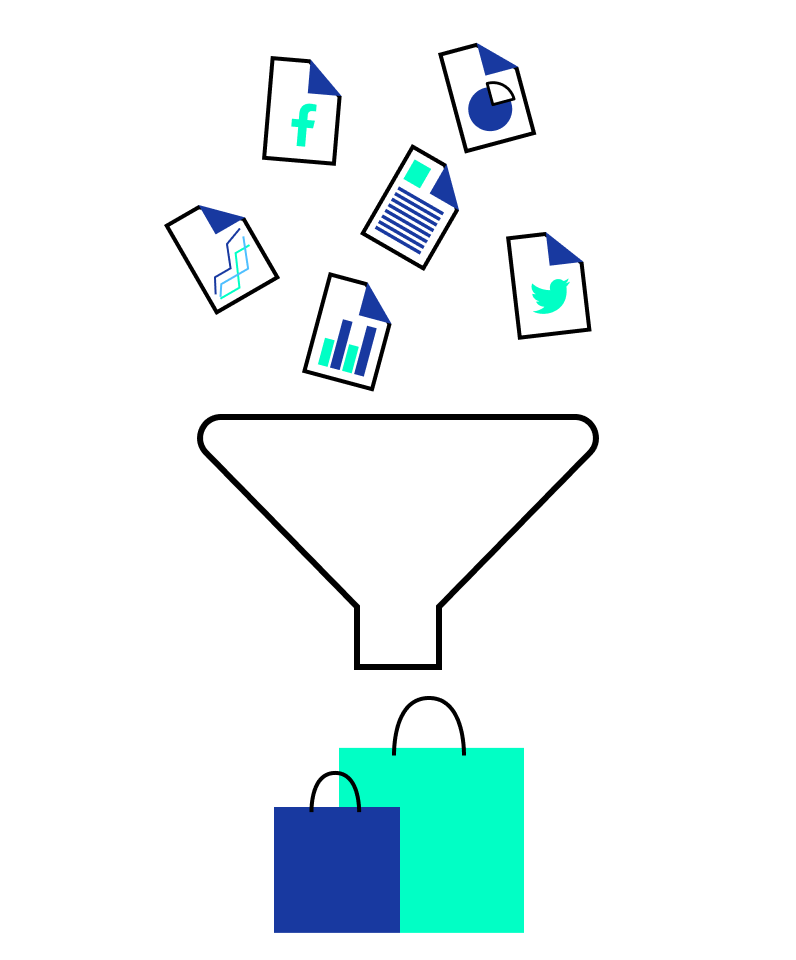
Fashionette, an online retail company, for example, has embraced data integration like there is no tomorrow. For its data-driven business, the marketing team needed to integrate over 40 different data sources in order to create a coherent overview of all marketing activities and measure ROI. ETL and data integration tools that can provide such a service are often rather complex and have integrated APIs to support a more diverse set of data sources.
A few years back perhaps, you could collect and keep track of all your marketing data in a single Excel file. This is hardly the case anymore – not at all, in fact, if we’re completely honest. Today, you need a designated space, perhaps even in the cloud, for the data that is coming in on a minute-by-minute basis. You need a data warehouse.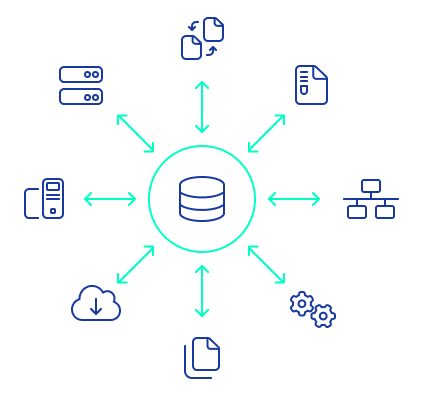
A data warehouse is a central hub that lets you store all your data to be used for reporting and data analytics – a single location even if the data comes from multiple sources.
There is little doubt that having all of your (marketing) data in one place is a good thing. For one, you get quick and easy access to the data you need, without having to pull it from a bunch of sources. That can be quite frustrating especially if you’re on a tight deadline to deliver insights.
“A data warehouse converts data from multiple sources into a common format to help verify its consistency and quality for marketing purposes,” according to marketing platform Chainlink.
A small inconsistency or a missing piece of your data can cause a chain reaction of wrong insights unless you catch it early on. This clean, high-quality data is something you need to strive towards at all times.
Also, a data warehouse can help you store all the marketing data you have so you can compare past and present performance, and make decisions for the future.
“Users can uncover trends they might miss if they looked only at the latest batch of numbers. If you want to do advanced analytics, you need a huge body of past results to build accurate predictions. Only a data warehouse is big enough to store everything you need”
If you’re looking for speed, tight security, and control, an on-premise data warehouse may be the choice for you. You are sure to have all your data in the server room at the back of your office, making it as secure as it possibly can be. Security is also the main benefit of the cloud, where protocols are being updated on a regular basis and potential bugs are being fixed as soon as they are detected.

Speed is certainly a stronger feat for on-premise solutions since users do not have to wait on data to bounce through multiple servers – often in multiple, far-away countries.
In terms of reliability, both solutions have their advantages, with the difference that in the cloud, you depend on choosing the right provider, while in-house, you can hire the experts you need and have them physically there in case a problem arises.
I see the roles changing [… and] that includes the rise of the marketing technologist as being a fundamental person on the team
- Scott Hagedorn, CEO of Omnicom’s new media agency Hearts & Science
In this day and age, handling (marketing) data manually is a no-go. Nothing against Excel Sheets, but they simply can’t do the job anymore. To really make good use of their data, professionals need to embrace data integration tools and their potential to deliver clean, structured and ready-to-analyze data.
Nowadays, data flows in and out of different sources, so managing it from beginning to end can be a rather complex process. It is not just about collecting it or transforming it or analyzing it. It’s about all of the above in one – and quite often in a very short time frame, too. Make your way through the individual phases and ensure that no one of them remains neglected.
The main challenge in the transformation phase of your data is achieving the right (and best possible) quality of that data. Before you move on to deriving your insights, you need to make sure that your data is properly harmonised, especially with regard to its completeness, consistency and timeliness. The last of those three can be particularly challenging since different sources push data at different intervals of time and in a multitude of formats.
You should underestimate the fact that even the slightest error in your initial data can have serious consequences for the decisions you make based on it later on. Integrating data at the deepest level possible is, thus, something for professionals to embrace – and the sooner, the better. Take Drill-down reporting, for example.
“The best way to integrate data is at the product level because then the BI tool can automatically merge it with the higher levels as needed. Integrating data directly at the company level, for example, will open up challenges when generating product-level drill-down reports.”
We may not (want to) think about it too often, but when it comes to big data and scalability, the two practically go hand in hand. Being ready to handle increasing amounts of data on a daily basis is already becoming a must for many marketing professionals out there. Unfortunately, not many realize that before they embrace a specific BI tool. Don’t be one of them.

While many organizations still believe that data activities can and should be outsourced, more and more tend to agree that having great data talent in-house is quite important, too. In our survey, more than 50% of respondents said they have multiple people responsible for the data integration process, and 47% have already created a dedicated position – anything from Data Analyst to Head of Data Technology and Chief Data Officer.